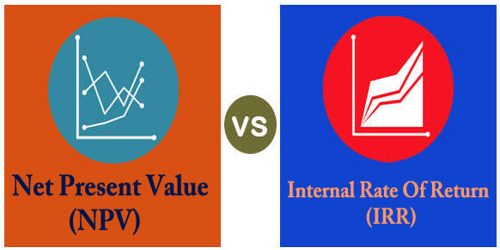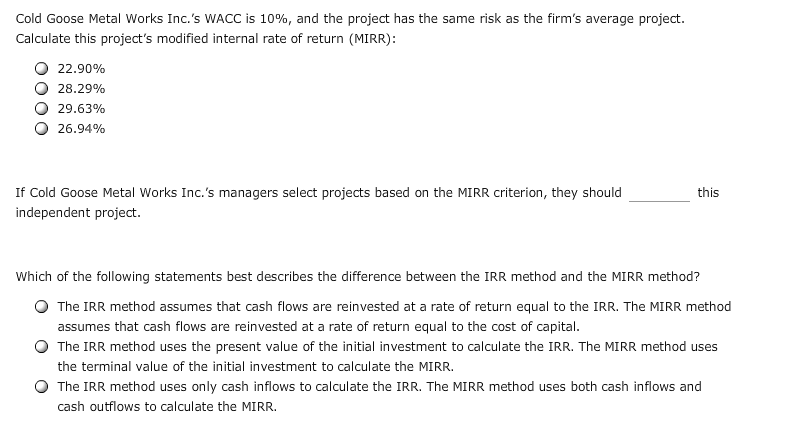
However, in a certain project, both the two criterion give contradictory results, i.e. one project is acceptable if we consider the NPV method, but at the same time, IRR method favors another project. The internal rate of return (IRR) cannot be singularly used to make an investment decision, as in most financial metrics. In the context of a leveraged buyout (LBO) transaction, the minimum internal rate of return (IRR) is usually 20% for most private equity firms. The internal rate of return (IRR) metric is an estimate of the annualized rate of return on an investment or project. Here, CFt represents the cash flow at time t, while n is project duration, CO denotes cash outflow and CI signifies cash inflow.
The Formula for IRR
Just as with net present value, you have to consider whether you are looking at an independent or mutually exclusive project. For independent projects, if the IRR is greater than the cost of capital, then you accept as many projects as your budget allows. For mutually exclusive projects, if the IRR is greater than the cost of capital, you accept the project.

The Formula for the Internal Rate of Return
Within its realm of uses, IRR is a very popular metric for estimating a project’s annual return; however, it is not necessarily intended to be used alone. IRR is typically a relatively high value, which allows it to arrive at an NPV of zero. The IRR itself is only a single estimated figure that provides an annual return value based on estimates. Since estimates of IRR and NPV can differ drastically from actual results, most analysts will choose to combine IRR analysis with scenario analysis. Scenarios can show different possible NPVs based on varying assumptions. If two or more projects are mutually exclusive, the decision to invest in one project precludes investment in all the others.
- If a firm can’t find any projects with an IRR greater than the returns that can be generated in the financial markets, then it may simply choose to invest money in the market.
- In other words, to get a future value of $7,764 with monthly payments of $50 per month for 10 years, the IRR that will bring that flow of payments to a net present value of zero is 5%.
- And if dividends are not assumed to be reinvested, are they paid out, or are they left in cash?
- To determine the crossover rate, where the NPVs of two projects are equal, you can use Excel’s Goal Seek function.
- The net present value (NPV) and the internal rate of return (IRR) are both techniques that financial institutions or individuals can use when they are making major investment decisions.
- Here, CFt represents the cash flow at time t, while r denotes the discount rate (the project’s cost of capital), and n is the project duration.
Understanding the Internal Rate of Return (IRR) Rule
Without a computer or financial calculator, IRR can only be computed by trial and error. Conceptually, the IRR can also be considered the rate of return, where the net present value (NPV) of the project or investment equals zero. The project is expected to return 16% on that capital and, therefore, adds value. Another situation that causes problems for people who prefer the IRR method is when the discount rate of a project is not known. In order for the IRR to be considered a valid way to evaluate a project, it must be compared to a discount rate.
This decision would be wrong when we consider the sizes of the NPVs of the projects. The best decision would be to go for the project with the highest NPV, and that is project Z. Therefore, if projects are mutually exclusive, the NPV method should be applied. Once the cash flow values have been fed into the calculator, you are ready to calculate the IRR. During the computation of Net Present Value, the discount rate is assumed to be known, and it remains constant. But, while calculating IRR, the NPV fixed at ‘0’ and the rate which fulfills such a condition is known as IRR.
The IRR and NPV can produce different ranking outcomes whenever mutually exclusive projects are involved. To determine the internal rate of return (IRR) on the LBO investment in Excel, follow the steps below. Suppose a private equity firm made an equity investment of $85 am i eligible for the earned income tax credit million in 2022 (Year 0). In many respects, NPV is considered a superior metric to IRR because it directly reflects the net value added to the firm. However, IRR cannot be entirely disregarded, as it remains one of the most widely used metrics in corporate finance.
AFP’s mission is to drive the future of finance and treasury and develop the leaders of tomorrow through certification, training, and the premier event for treasury and finance. NPV is sensitive to changes in the discount rate, decreasing as the rate increases, while IRR stays constant. For comparisons of investment efficiency or in situations where the cost of capital is uncertain, IRR might be preferred.
In general terms, the higher the internal rate of return, the more desirable it is to undertake an investment. The IRR is uniform for investments of different types and, as such, can be used to classify multiple potential investments or projects on a relatively uniform basis. In general, when comparing investment options with other similar characteristics, the investment with the highest IRR would likely be considered the best. The ultimate goal of the IRR is to identify the discount rate that makes the present value of the sum of nominal annual cash inflows equal to the initial net investment outlay. It should be noted that the IRR is the growth rate that an investment is expected to generate annually. Therefore, it can be very similar to a compound annual growth rate (CAGR).
